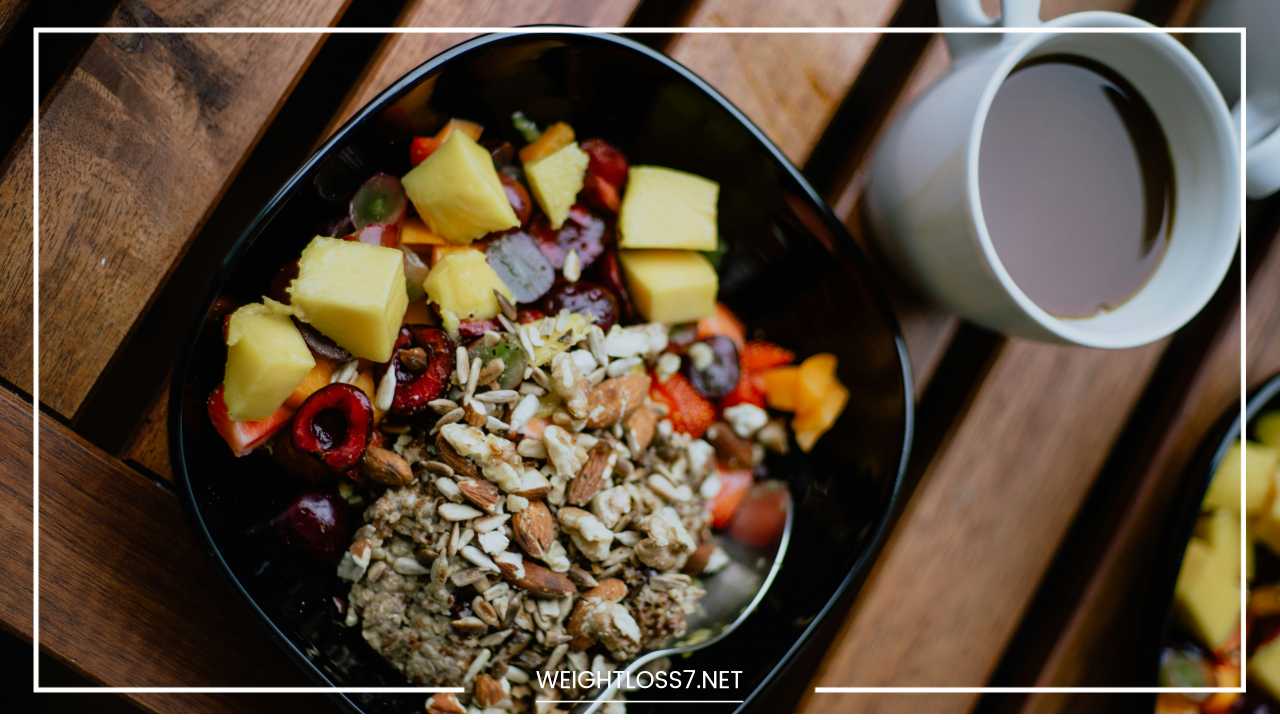Fiber for Weight Loss: The Unsung Hero & How to Eat More

Fiber for Weight Loss
Fiber and Weight Loss: The Unsung Hero of Your Journey
We all know the frustration. You embark on a weight loss journey, armed with detailed meal plans and rigorous exercise routines, only to find yourself constantly battling hunger pangs and cravings.
What if there was a secret weapon hiding in plain sight, a dietary hero that could help you feel fuller for longer and support your weight loss goals?
Enter fiber, the often-overlooked nutrient that deserves a starring role in your health and weight management plan.
This comprehensive blog post dives deep into the fascinating world of fiber, exploring its various types, its multifaceted impact on weight loss, and how to incorporate more of it into your diet for long-term success.
We’ll also delve into the science behind the gut microbiome and how fiber fuels its function, ultimately influencing weight management.
The Power of Fiber: A Multifaceted Approach
Fiber isn’t just about keeping things moving smoothly in your digestive system. It’s a complex carbohydrate that our bodies can’t fully digest, offering a unique set of benefits for weight loss. Here’s how fiber works its magic on multiple fronts:
1. Feeling Fuller for Longer: There are two main types of fiber – soluble and insoluble. Soluble fiber, found in fruits, vegetables, and oats, absorbs water in your digestive tract, forming a gel-like substance that slows down digestion.
This keeps you feeling satiated for longer, reducing cravings and preventing you from overeating at your next meal. Studies have shown that people who consume higher amounts of soluble fiber tend to eat fewer calories throughout the day.
2. Blood Sugar Control: Fiber helps regulate blood sugar levels. By slowing down the absorption of sugar from food, it prevents blood sugar spikes and crashes that can lead to increased hunger and cravings for sugary snacks. This can be especially helpful for managing cravings and preventing overeating, especially between meals.
3. Enhanced Metabolism: While fiber itself doesn’t directly burn calories, the process of digesting it does require your body to expend some energy.
This slight increase in energy expenditure, known as the thermic effect of food (TEF), can contribute to a small but noticeable boost in metabolism.
4. Reduced Calorie Absorption: Some types of fiber, particularly viscous fiber, may bind to dietary fats in the digestive tract, preventing them from being fully absorbed by the body. This can lead to a slight reduction in overall calorie intake.
5. Appetite Hormone Modulation: Fiber may influence the production of hormones that regulate hunger and satiety. Studies suggest that soluble fiber may help decrease levels of ghrelin, the “hunger hormone,” and increase levels of peptide YY (PYY), a hormone that promotes feelings of fullness.
The Gut Connection: How Fiber Fuels a Healthy Microbiome
Our gut is a complex ecosystem teeming with trillions of bacteria, often referred to as the gut microbiome. These tiny residents play a crucial role in digestion, immune function, and even weight management.
Here’s where the fiber story gets even more interesting. Insoluble fiber, found in whole grains and vegetables, acts as a prebiotic, feeding the good bacteria in your gut. This promotes a healthy gut microbiome, which has been linked to improved weight management and overall health.
A healthy gut microbiome helps regulate hormones that control hunger and satiety. It may also influence how your body absorbs nutrients from food, potentially impacting weight management in various ways.
Studies suggest that an imbalanced gut microbiome may be linked to increased inflammation and insulin resistance, both of which can contribute to weight gain.
There’s also emerging research suggesting that the gut microbiome may influence how efficiently your body stores fat. A healthy gut microbiome may promote the storage of energy in muscles as opposed to fat cells [9].
Beyond Weight Loss: The All-Encompassing Benefits of Fiber
Fiber’s benefits extend far beyond weight loss. Here are some additional reasons to embrace a fiber-rich diet:
- Improved Heart Health: Fiber helps lower LDL (“bad”) cholesterol and may reduce the risk of heart disease by preventing the buildup of plaque in arteries.
- Reduced Risk of Type 2 Diabetes: Fiber helps regulate blood sugar and may lower the risk of developing type 2 diabetes by improving insulin sensitivity.
- Promotes Digestive Health: Fiber keeps things moving smoothly, preventing constipation and promoting regularity. It may also help reduce the risk of hemorrhoids and diverticulitis.
- May Lower Risk of Certain Cancers: Studies suggest a link between a high-fiber diet and a reduced risk of colorectal cancer.
- Increased Satiety May Lead to Reduced Overall Food Intake: Feeling full for longer can naturally lead to consuming fewer calories throughout the day, potentially aiding in weight management efforts.
How Much Fiber Do You Need?
The recommended daily intake of fiber for adults varies depending on age, sex, and overall calorie intake. Here’s a breakdown:
- Women: 25 grams per day (based on a 2,000 calorie diet)
- Men: 38 grams per day (based on a 2,000 calorie diet)
However, most people fall short, consuming only around 10-15 grams daily.
Here’s a helpful tip: You can estimate your daily fiber needs by multiplying your daily calorie intake by 0.014. For example, if you consume 1,800 calories daily, you would aim for roughly 25 grams of fiber (1800 x 0.014 = 25.2).
Filling Your Plate with Fiber Powerhouse Foods:
Now that you know the importance and recommended intake of fiber, let’s explore how to incorporate more of it into your diet. Here’s a breakdown of delicious, fiber-rich foods to add variety and flavor to your meals:
Fruits (with skin whenever possible):
- Berries (raspberries, blueberries, strawberries)
- Apples
- Pears
- Oranges
- Figs
Vegetables:
- Leafy greens (spinach, kale)
- Broccoli
- Brussels sprouts
- Carrots
- Sweet potatoes
- Artichokes
Whole Grains:
- Brown rice
- Quinoa
- Oats
- Whole-wheat bread and pasta
- Barley
Legumes:
- Beans (kidney beans, black beans, pinto beans)
- Lentils
- Chickpeas
Nuts and Seeds:
- Almonds
- Walnuts
- Flaxseeds
- Chia seeds
Pro Tip: When switching to a higher-fiber diet, start slowly and increase intake gradually to avoid bloating and gas. This allows your gut bacteria time to adjust to the increased fiber load.
Fiber-Fueled Recipes for Weight Loss Success:
Here are some recipe ideas to get you started on your fiber-rich journey:
High-Fiber Breakfast:
- Overnight oats with berries, chia seeds, and a sprinkle of nuts
- Smoothie made with Greek yogurt, spinach, banana, and flaxseed
- Whole-wheat toast with avocado and a scrambled egg
Lunch Powerhouse:
- A big salad with grilled chicken, quinoa, roasted vegetables, and a fiber-rich dressing (e.g., balsamic vinaigrette)
- Lentil soup with a side of whole-wheat bread
- Black bean burger on a whole-wheat bun with a side salad
Fiber-Rich Dinner:
- Salmon with roasted Brussels sprouts and brown rice
- Vegetarian chili made with kidney beans, black beans, corn, and whole-wheat bread for dipping
- Chicken stir-fry with whole-wheat noodles and plenty of vegetables (broccoli, carrots, peppers)
Sweet Treat with a Twist:
- Baked apples with a sprinkle of cinnamon and chopped nuts (skip the sugary toppings!)
- Chia pudding with berries and a drizzle of honey
- Dark chocolate with almonds (enjoy in moderation!)
Remember: Cooking with a variety of these fiber-rich ingredients ensures you get a good balance of both soluble and insoluble fiber, maximizing the health benefits.
Beyond the Plate: Additional Tips to Maximize Fiber Intake
Here are some additional ways to boost your fiber intake and create sustainable dietary changes:
- Snack on fiber-rich options: Opt for almonds, edamame, or apple slices instead of processed snacks like chips or cookies.
- Choose whole grains over refined ones: Swap white bread for whole-wheat and brown rice for white rice whenever possible. This simple switch significantly increases your fiber intake.
- Add a sprinkle of fiber: Consider adding flaxseed or chia seeds to smoothies, yogurt parfaits, or even oatmeal for an extra fiber boost.
- Read food labels: Pay attention to the fiber content on food labels. Look for products with at least 3-4 grams of fiber per serving.
- Bulk up soups and stews: Add lentils, beans, or chopped vegetables to your favorite soups and stews for a hearty and fiber-rich meal.
- Start your day with fiber: Aim for a breakfast that includes a good source of fiber, such as oatmeal, whole-wheat toast with avocado, or a fruit and yogurt parfait with chia seeds.
Building Sustainable Habits for Long-Term Success
Fiber is a powerful tool for weight loss and overall health, but it’s important to remember that sustainable dietary changes are key. Here are some tips for building long-term habits:
- Focus on adding, not restricting: Instead of feeling deprived, focus on adding more fiber-rich foods to your diet which can naturally crowd out less healthy options and leave you feeling satisfied and energized throughout the day.
- Make gradual changes: Don’t try to overhaul your diet overnight. Start by incorporating one or two new fiber-rich foods into your meals each week. Slowly increase your intake over time to allow your body to adjust.
- Plan your meals and snacks: Planning ahead helps you make healthy choices and avoid unhealthy temptations. Stock your pantry and fridge with fiber-rich options for convenient snacking and meal preparation.
- Get creative in the kitchen: Experiment with new recipes that incorporate fiber-rich ingredients. There are endless possibilities for delicious and healthy meals that are packed with fiber.
- Find a support system: Share your weight loss goals and dietary changes with friends and family. Having a support system can keep you motivated and accountable.
- Don’t be discouraged by setbacks: Everyone has slip-ups. If you indulge in a less-than-healthy choice, don’t beat yourself up. Simply get back on track with your next meal.
- Celebrate your progress: Acknowledge and celebrate your achievements, no matter how small. This will help you stay motivated and keep moving forward.
Understanding Fiber Supplements: A Complementary Approach
While incorporating fiber-rich foods into your diet is the most natural and recommended approach, fiber supplements can be a helpful tool in certain situations. Here’s what you need to know:
- Types of Fiber Supplements: There are various types of fiber supplements available, including psyllium husk, wheat bran, and methylcellulose. Each type has slightly different properties and benefits.
- Consult your doctor: Before starting any fiber supplement, it’s essential to consult with your doctor, especially if you have any underlying health conditions.
- Potential Side Effects: Fiber supplements can cause bloating, gas, and cramps, especially if you start with a high dosage. It’s important to increase intake gradually to minimize these side effects.
- Fiber Supplements are not a Magic Bullet: Remember, fiber supplements are not a magic bullet for weight loss. They should be used alongside a healthy diet and regular exercise for optimal results.
Final Word: Fiber – Your Ally in Weight Loss and Overall Health
Fiber is a powerful and often underestimated nutrient that plays a crucial role in weight loss, gut health, and overall well-being.
By incorporating a variety of fiber-rich foods into your diet and gradually increasing your intake, you can experience a sense of sustained fullness, improved blood sugar control, and a healthier gut microbiome.
This, combined with a healthy lifestyle that includes regular exercise and adequate sleep, can pave the way for lasting weight loss success and a healthier you.
Remember, building sustainable habits is key. Focus on adding delicious and nutritious fiber-rich foods to your diet, experiment with healthy recipes, and don’t be discouraged by setbacks.
With dedication and the right tools, fiber can become your powerful ally in your weight loss journey and overall health goals.

















